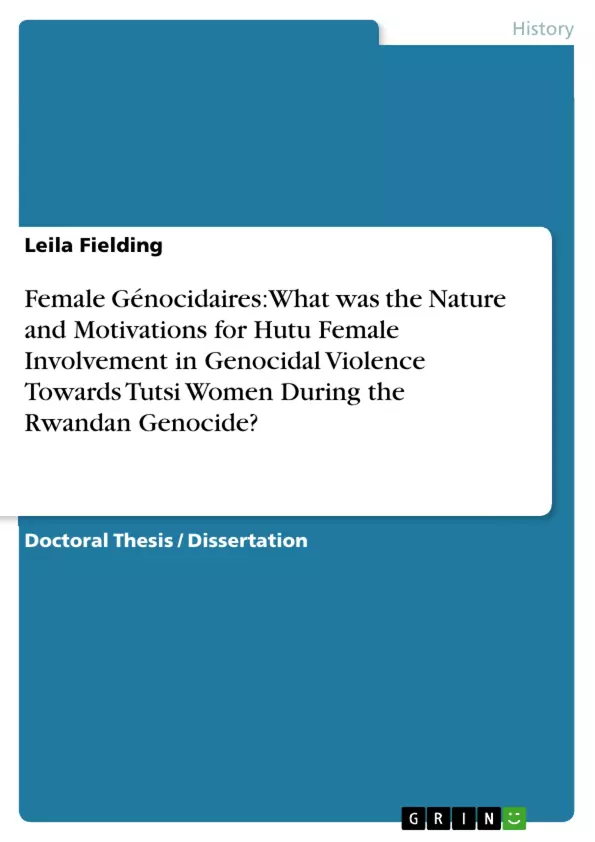Victimisation of women in times of war, genocide or mass slaughter has been the primary focus of the majority of explorations concerning gender and conflict. Traditionally, women are espoused as victims, at the mercy of male killers and therefore subordinate. The notoriety of brutal, horrific and incomprehensible sexual crimes against women in times of genocide has ensured that reluctance in addressing female accountability has plagued this debate. While examinations of these atrocities are imperative and indispensable in facilitating reconciliation, both psychological and social, this one-sided representation has led to a misunderstanding of the dynamic roles which women play during genocide. Whether supportive, active or auxiliary roles, women have been a vital component in endorsing and sanctioning genocidal violence historically. In Rwanda, some women not only provided assistance and encouragement to Hutu men, but also perpetrated the attacks and incited rape. The suffering of female victims cannot be fully understood without a consideration of the extensive nature of the perpetrators, both male and female. Moreover, quite the opposite of diminishing the value and significance of the victimisation of women, any examination which focuses on female agency re-balances the scales of gender inequality and consequently serves to empower women. Women should not be portrayed solely as victims. Women in the Rwandan genocide were victims and perpetrators, agents and symbols. Gender expectations which propagate the superiority of men both during and after conflict are detrimental to the reconstruction of post-genocide gender identities.
Table of Contents
- Introduction
- Objectives
- Methodology
- Argument
- Chapters:
- Gender and conflict
- Gender as a social and cultural construct
- Established gender norms
- The nature of female involvement
- Pre-genocide gender roles in Rwanda
- Who were the female perpetrators?
- What was the extent of women's participation?
- What was the nature of women's participation?
- Women in leadership roles
- Case Study: Pauline Nyiramasuhuko
- Motivations of 'ordinary' women
- Fear and Coercion
- Habit of obeying official orders
- Gendered propaganda
- Jealousy and ethnic rivalry
- Ideology and ethnic racism
- Greed and opportunism
- Gender and conflict
Objectives and Key Themes
This dissertation aims to explore the roles of women in perpetrating the violence of the Rwandan genocide, revealing the largely unexplored dimensions of their involvement. It seeks to answer questions about the agency of women in genocide and explore the factors that led them to defy typical gender norms and commit acts of violence against their fellow women. The study will examine the motivations behind this behavior and analyze the social and cultural factors that might have contributed to women's participation in the genocide. Key themes explored include:- The role of gender and ethnicity in shaping women's participation in the genocide
- The motivations behind women's involvement, including fear, coercion, and ideological influences
- The extent and nature of women's participation, from providing assistance to active perpetration of violence
- The influence of gender roles and propaganda on women's decision-making
- The impact of female involvement on post-genocide Rwanda, particularly in relation to gender identity and social reconciliation
Chapter Summaries
This dissertation begins by exploring the concept of gender as a social and cultural construct and examines how established gender norms influenced women's roles in Rwandan society. It then delves into the nature of female involvement in the genocide, examining the extent and nature of their participation. Chapter 3 focuses on women in leadership roles, using the case study of Pauline Nyiramasuhuko to demonstrate the agency of women in times of conflict. Chapter 4 investigates the motivations of 'ordinary' women in committing atrocities, exploring factors such as fear, coercion, gendered propaganda, and ethnic rivalry. This dissertation does not include summaries of the conclusion or any sections containing major revelations or spoilers.Keywords
This dissertation explores the themes of female agency, gender roles, genocide, and ethnic conflict, specifically focusing on the Rwandan genocide. It examines the motivations behind women's involvement in violence, considering factors such as fear, coercion, propaganda, and ethnic rivalry. The study also analyzes the role of gender and ethnicity in shaping women's participation in the genocide and their impact on post-genocide Rwanda. Key terms include: genocide, female agency, gender roles, ethnic conflict, propaganda, Rwanda, motivation, and post-genocide reconciliation.- Quote paper
- Leila Fielding (Author), 2012, Female Génocidaires: What was the Nature and Motivations for Hutu Female Involvement in Genocidal Violence Towards Tutsi Women During the Rwandan Genocide?, Munich, GRIN Verlag, https://www.grin.com/document/199827



